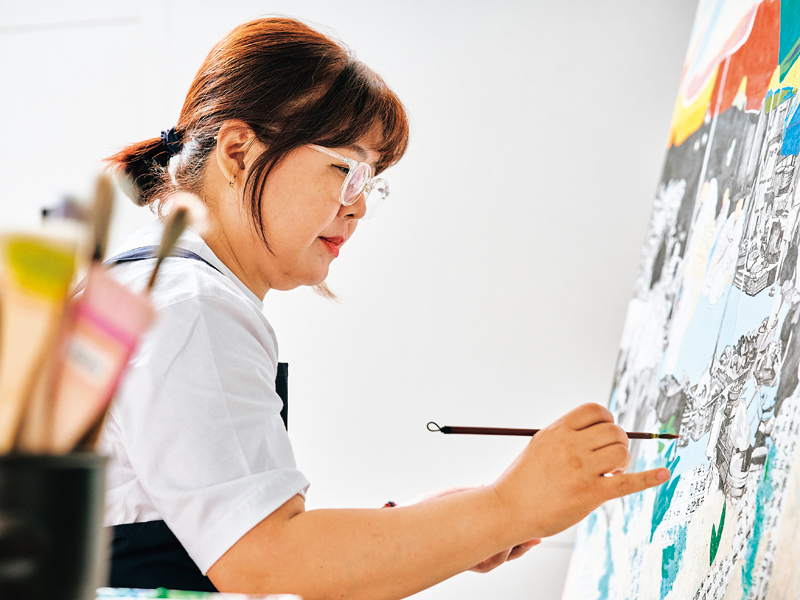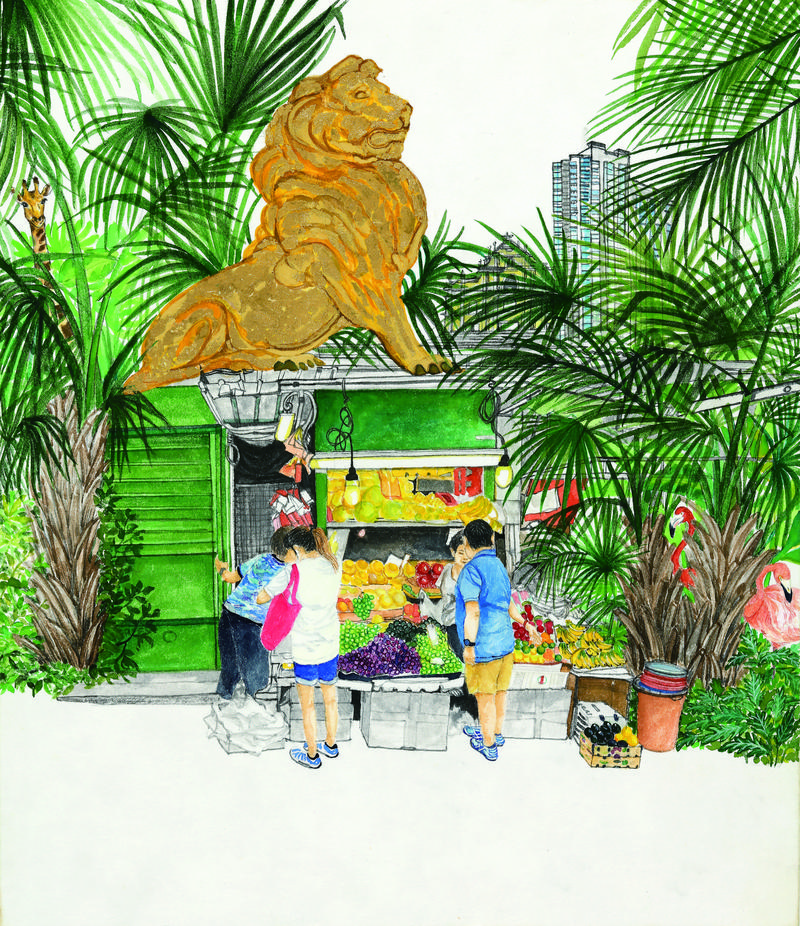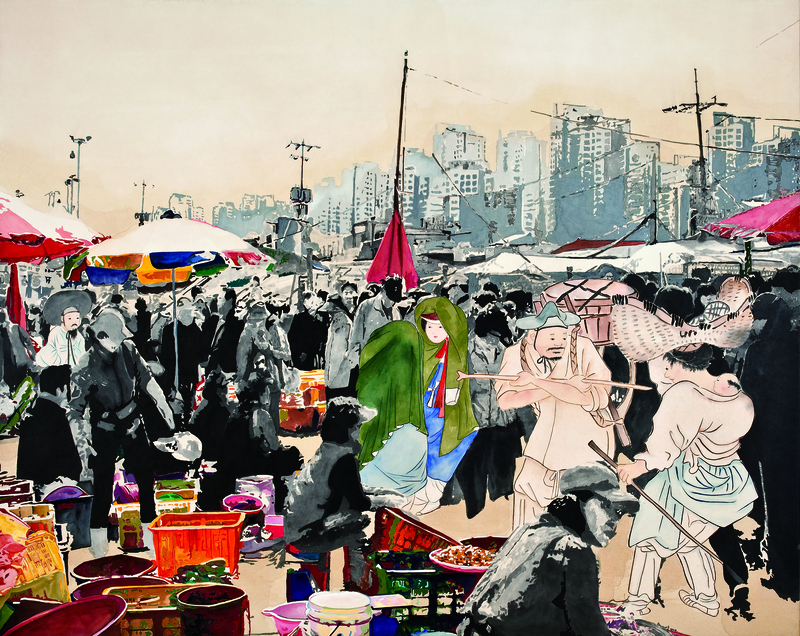Artist Choi Eun-sook’s works often superimpose figures from the past onto traditional marketplaces of today. By transcending time and space and harnessing the characteristics of traditional East Asian painting, the artist s a utopia all her own.

I Was with Them. 2012. Mixed colors on paper. 130 x 388 cm.
Using ink, the fundamental building block of traditional East Asian painting, and acrylic paint, the main material of contemporary Western painting, Choi Eun-sook s genre paintings that combine modern elements and traditional East Asian painting techniques. A recurring subject in her paintings is the traditional market, rich with memories of her childhood. The resulting works, in which figures from the Joseon Dynasty (1392-1910) populate scenes from traditional markets that remain today, guide viewers into a kind of imagined sanctuary that is both mysterious and peaceful.
How did you get into traditional East Asian painting?
While studying design at university, I happened to fall in love with meok (inksticks), the time-honored medium of traditional East Asian painting. The ink’s concentration is controlled by the amount of water you mix it with, and in using it I came to realize that traditional East Asian painting expresses richness of color and depth in a different way from Western watercolors. That led me to transfer to the Department of Oriental Painting, and I went on to complete Master’s and Ph.D. programs in Oriental Painting at Hongik University. Since then, I have been experimenting with combining ink with acrylic paint. I think I am drawn to the wide array of color changes that can occur when water-soluble materials meet water.
What is behind your choice of traditional markets as motif?
As a child, I often ran errands for my mother. Unlike my friends, who hated it, I loved doing that. It was so much fun to go and explore the traditional markets. Just the sight of the parasols lining the market’s alleyways would make my heart skip a beat, and the baskets full of colorful fruits were always a feast for the eyes. My mom would be in a hurry, needing something like tofu, so she would send me to buy it, but I would become so engrossed in looking around at the market that I wouldn’t even think about going home.
Your paintings take me back to my own childhood.

When Choi Eunsook paints traditional markets, she taps memories of her childhood toutopias where time and space overlap.
© Heo Dong-wuk
That is precisely the reaction I hope for. When people can relate so directly to how I myself felt as a child, in those traditional markets, I am just so grateful it almost brings tears to my eyes. If someone were to ask me for a definition of
jeong (a distinctly Korean term that shares valence with “warm affection” or “affinity”), I would tell them to go to their local traditional market. All markets are places where you can feel the joys and sorrows of life, but it’s especially at traditional Korean markets that you can experience the uniquely Korean phenomenon that is jeong.
You often use figures from Joseon genre paintings.
When I was a senior at university, I experienced an optical illusion at Namdaemun Market in Seoul where I suddenly saw a series of figures from Joseon genre paintings superimposed on the scene in front of me—and in that moment, I immediately thought, “Why not try translating this into a painting?” The project I started then has continued to this day. I wanted it to feel as though time had stopped, so in some of the works, the figures from the past are in color, while those from the present are in black and white. Essentially, I wanted tofigures that transcend time and space, and that, in a nutshell, is the thematic consciousness running through my work. As for the figures from the past, I often borrow characters from genre paintings by the Joseon Dynasty painters Shin Yun-bok (1758-c. 1813) and Kim Hong-do (1745-c. 1806).
Please tell us more about your process.
First, I visit the traditional market I want to paint and take photos, and then Ia story by arranging characters from old genre paintings on top of them. Once I am done plotting the story, I draw and color on paper. However, before painting, I first apply a solution of glue and alum dissolved in water to the paper to prevent the meok from smearing or bleeding, and to prepare the texture of the paper.
What do you use for the shimmering effect?
One of the materials used in traditional East Asian painting is stone powder, which is made from crystals. This is mixed with glue and applied to the paper toa shiny surface. Unlike Western painting, traditional East Asian painting often uses natural pigments like ink and stone dust.
Do all markets in your works exist?

Mental Landscape. 2020. Mixed colors on paper. 53 x 45 cm.
They do, but none exactly match reality. For example, Mental Landscape is set at a market in Hong Kong, but the statue above the fruit stall in the painting is the Golden Lion from the MGM Hotel in Macau, not Hong Kong. In this way, my work is based on reality, but I mix and match elements from different times and places tonew compositions.
I noticed that some works have blurred backgrounds.

One Autumn Day with Them. 2011. Mixed colors on paper. 30 x 120 cm.
I wanted to emphasize a mysterious atmosphere by superimposing a thin, transparent hanji (traditional Korean paper) made of rice depicting the current landscape on top of the jangji (a thicker and more durable type of hanji) depicting the background of a genre painting. Even when I change the locations at will, though, visitors who love traditional markets will still recognize them in the paintings. One time, a visitor immediately recognized the market in Gurye, South Jeolla Province, just by the camellia flower design on the market floor.
You must have visited many traditional markets.

Times of Coexistence. 2011. Mixed colors on thick Korean paper. 130 x 162 cm.
Over the last ten years, I have gone on quite a few trips planned around traditional markets in Korea—but there are still countless of them that I’ve never visited. Some are famous for their chili peppers, others for their Korean beef, and so on; and even in the same market, the scenery changes depending on the season, so I always get a new impression. It’s sad that these days, so many traditional markets are gradually disappearing or losing their old appearance. That’s why I want to preserve as much of them as I can through my paintings.
Do you have any particular plans for the future?
I recently released a new piece, and fortunately the response was not bad, so I plan to continue this type of work. In it I placed landscapes and figures in and around a square cube toa kind of artificial stage set of my inner thoughts. The background of the traditional market may be gone, but this new work still centers on Koreanness, just like before.